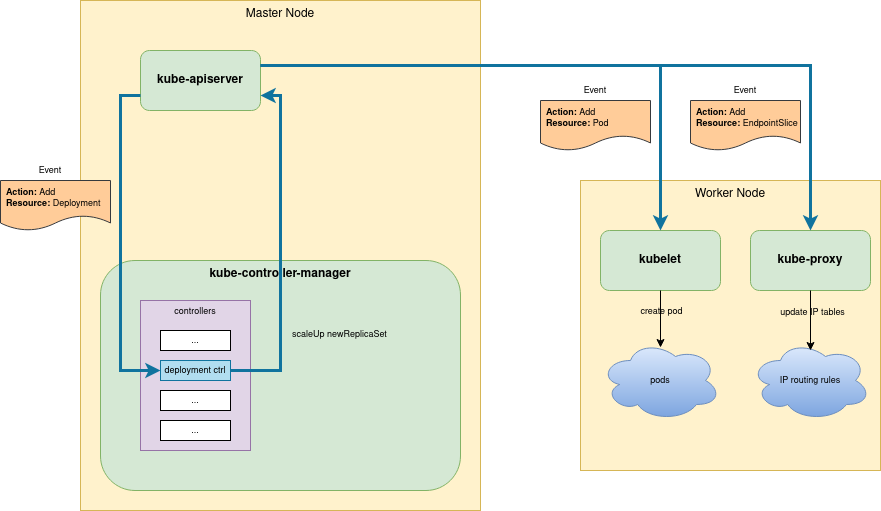Kubernetes is a platform that automates many of the complexities behind deployment, scaling, and management of resources, such as pods. Users can configure these resources imperatively using kubectl, or declaratively using configuration files (also deployed using kubectl). At the heart of this platform lies a control loop that works to bring the current state of those resources to the desired state.
In this article we will take a brief look at the component that manages the main control loop, kube-controller-manager, as well as the cloud-controller-manager that manages the control loops specific to cloud environments.
Architecture

“CM” represents kube-controller-manager and “CCM” represents cloud-controller-manager.
The controller manager is part of Kubernetes’ control plane1 and runs on the master nodes, normally as a standalone pod. It manages many built-in controllers for different resources such as deployments or namespaces. You can find the full list of managed controllers here.
Kubernetes implements an event-driven architecture with many independent components reacting to events and acting in concert to drive the system to a desired state. The controller manager registers “watches” on the API server that open a connection through which events are constantly streamed2. Each of these events has an associated action, such as “add” or “delete”, and a target resource. Here’s an example from the docs:
1
2
3
4
5
6
7
8
9
10
11
12
13
14
15
GET /api/v1/namespaces/test/pods?watch=1&resourceVersion=10245
---
200 OK
Transfer-Encoding: chunked
Content-Type: application/json
{
"type": "ADDED",
"object": {"kind": "Pod", "apiVersion": "v1", "metadata": {"resourceVersion": "10596", ...}, ...}
}
{
"type": "MODIFIED",
"object": {"kind": "Pod", "apiVersion": "v1", "metadata": {"resourceVersion": "11020", ...}, ...}
}
...
The event actions are determined by their type, and the target resource is the object. Note how object is just a regular spec (Pod specs in this example).
The controller manager dispatches these events to controllers that have registered themselves to act on them based on the event’s action and the type of the resource. Note that these controllers do not realize the end result directly (ie. create containers, create IP addresses, etc.), they merely update resources that are exposed on the API server itself. In other words, they update the desired state of those resources by posting the updated spec back to the API server. It is other components, such as the kubelet and the kube-proxy, perform the actual grunt work derived from the desired state.
 High level view of a small subset of what happens when a new deployment is added.
High level view of a small subset of what happens when a new deployment is added.
In the cloud
In cloud environments, the cloud-controller-manager runs alongside the kube-controller-manager. This controller manager operates the same way as the built-in kube-controller-manager in principle, with its control loops tailored specifically for management of cloud infrastructure. It is this controller manager that handles updates from the cloud provider: nodes automatically entering or leaving the cluster, provisioning of load balancers, updating IP routes within your cluster, and so on.
Conclusion
Kubernetes is a distributed system that serves as a platform that automates many of the complexities behind deployment, scaling, and management of applications. The kube-controller-manager implements many critical control loops that ensure the cluster’s current state matches the user’s desired state. These control loops function independently of each other, listening for events from the API server and modifying resources there as well. Other components, such as the kube-proxy and the kubelet perform the actual runtime configurations on the cluster’s nodes. In cloud environments, the cloud-controller-manager runs alongside the kube-controller-manager and implements control loops specific to cloud infrastructure.
Footnotes
Components on the control plane observe and adjust the network’s resources, topology, and routing tables in accordance with the desired state. See Wikipedia’s article on the control plane in the context of network routing. In contrast, the data plane is the part of a system that processes the actual traffic flowing through the network. Interestingly enough, Kubernetes does not have any components in the data plane. We already noted in a previous article how
kube-proxydoes not reside in this plane. Instead, it is a “Node Component” that configures IP routing rules on the local node. The local node’s network stack is in the data plane,kube-proxyis not. ↩These “watches” are based on etcd3’s Watch API. Breadcrumbs: registerResourceHandlers -> restulListResource -> ListResource -> -serveWatch -> WatchServer.ServeHTTP. Stepping back in reverse order, we see how the etcd3 watch is wired in: ListResource -> restfulListResource -> registerResourceHandlers; implementations of
rest.Watcher.Watch()include Store.Watch -> Store.WatchPredicate -> DryRunnableStorage.Watch; implementations ofstorage.Interface.Watch()include etcd3.store.Watch -> etcd3.watcher.Watch. ↩

